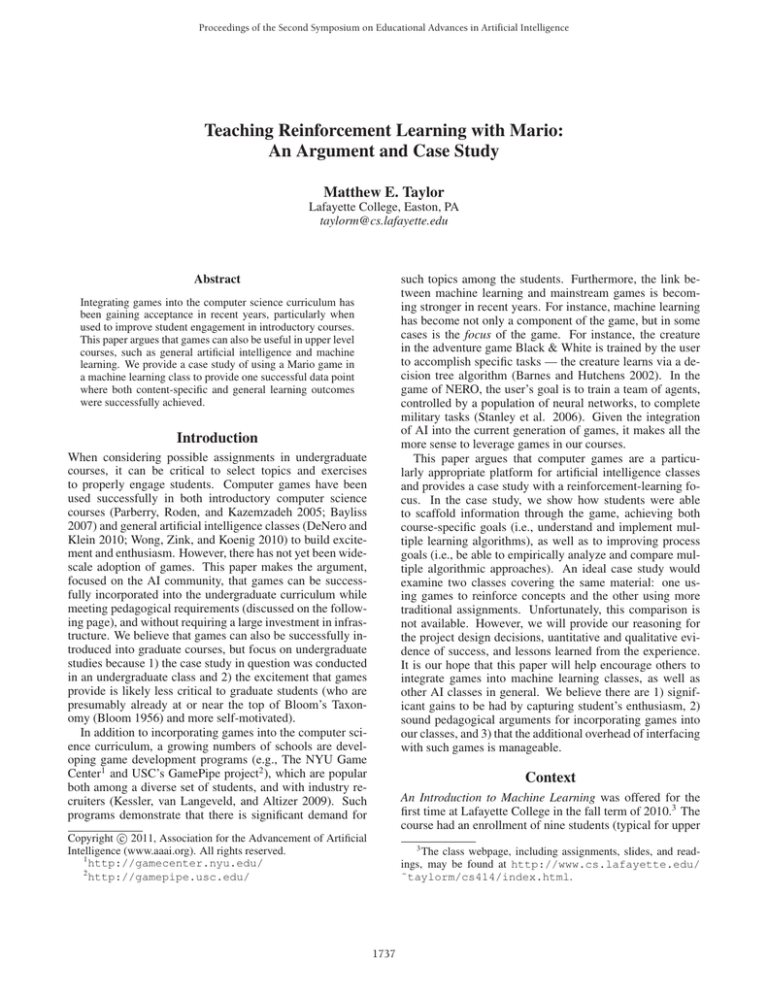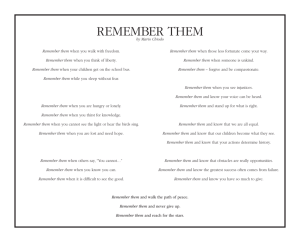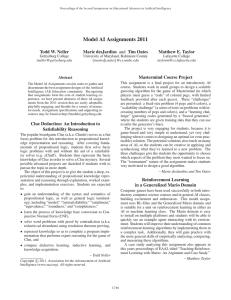
Proceedings of the Second Symposium on Educational Advances in Artificial Intelligence
Teaching Reinforcement Learning with Mario:
An Argument and Case Study
Matthew E. Taylor
Lafayette College, Easton, PA
taylorm@cs.lafayette.edu
such topics among the students. Furthermore, the link between machine learning and mainstream games is becoming stronger in recent years. For instance, machine learning
has become not only a component of the game, but in some
cases is the focus of the game. For instance, the creature
in the adventure game Black & White is trained by the user
to accomplish specific tasks — the creature learns via a decision tree algorithm (Barnes and Hutchens 2002). In the
game of NERO, the user’s goal is to train a team of agents,
controlled by a population of neural networks, to complete
military tasks (Stanley et al. 2006). Given the integration
of AI into the current generation of games, it makes all the
more sense to leverage games in our courses.
This paper argues that computer games are a particularly appropriate platform for artificial intelligence classes
and provides a case study with a reinforcement-learning focus. In the case study, we show how students were able
to scaffold information through the game, achieving both
course-specific goals (i.e., understand and implement multiple learning algorithms), as well as to improving process
goals (i.e., be able to empirically analyze and compare multiple algorithmic approaches). An ideal case study would
examine two classes covering the same material: one using games to reinforce concepts and the other using more
traditional assignments. Unfortunately, this comparison is
not available. However, we will provide our reasoning for
the project design decisions, uantitative and qualitative evidence of success, and lessons learned from the experience.
It is our hope that this paper will help encourage others to
integrate games into machine learning classes, as well as
other AI classes in general. We believe there are 1) significant gains to be had by capturing student’s enthusiasm, 2)
sound pedagogical arguments for incorporating games into
our classes, and 3) that the additional overhead of interfacing
with such games is manageable.
Abstract
Integrating games into the computer science curriculum has
been gaining acceptance in recent years, particularly when
used to improve student engagement in introductory courses.
This paper argues that games can also be useful in upper level
courses, such as general artificial intelligence and machine
learning. We provide a case study of using a Mario game in
a machine learning class to provide one successful data point
where both content-specific and general learning outcomes
were successfully achieved.
Introduction
When considering possible assignments in undergraduate
courses, it can be critical to select topics and exercises
to properly engage students. Computer games have been
used successfully in both introductory computer science
courses (Parberry, Roden, and Kazemzadeh 2005; Bayliss
2007) and general artificial intelligence classes (DeNero and
Klein 2010; Wong, Zink, and Koenig 2010) to build excitement and enthusiasm. However, there has not yet been widescale adoption of games. This paper makes the argument,
focused on the AI community, that games can be successfully incorporated into the undergraduate curriculum while
meeting pedagogical requirements (discussed on the following page), and without requiring a large investment in infrastructure. We believe that games can also be successfully introduced into graduate courses, but focus on undergraduate
studies because 1) the case study in question was conducted
in an undergraduate class and 2) the excitement that games
provide is likely less critical to graduate students (who are
presumably already at or near the top of Bloom’s Taxonomy (Bloom 1956) and more self-motivated).
In addition to incorporating games into the computer science curriculum, a growing numbers of schools are developing game development programs (e.g., The NYU Game
Center1 and USC’s GamePipe project2 ), which are popular
both among a diverse set of students, and with industry recruiters (Kessler, van Langeveld, and Altizer 2009). Such
programs demonstrate that there is significant demand for
Context
An Introduction to Machine Learning was offered for the
first time at Lafayette College in the fall term of 2010.3 The
course had an enrollment of nine students (typical for upper
c 2011, Association for the Advancement of Artificial
Copyright Intelligence (www.aaai.org). All rights reserved.
1
http://gamecenter.nyu.edu/
2
http://gamepipe.usc.edu/
3
The class webpage, including assignments, slides, and readings, may be found at http://www.cs.lafayette.edu/
˜taylorm/cs414/index.html.
1737
level electives), of whom seven were juniors and two were
seniors. The majority were B.S. students in computer science and the remainder were B.S. students in mathematics
or electrical and computer engineering. Roughly half of the
students had taken the Artificial Intelligence class as an elective in the fall of 2009.
There were no explicit prerequisites for the class, although all students were expected to be able to write “nontrivial” programs in Java, Python, C, or C++. Course objectives included:
Our decision to use Mario was motivated by both pedagogical and technical reasons. First, consider the pedagogical requirements of using a game in a teaching setting. For
instance Repenning, Webb, and Ioannidou, said that for
“. . . systemic impact, a computational thinking tool. . .
must fulfill all these conditions:
1. Has low threshold: a student can produce a working
game quickly.
2. Has high ceiling: a student can make a real game that
is playable and exhibits sophisticated behavior, e.g.,
complex AI.
3. Scaffolds flow: the curriculum provides stepping
stones with managed skills and challenges to accompany the tool.
4. Enables transfer: tool + curriculum must work for
both game design and subsequent computational science applications as well as support transfer between
them.
5. Supports equity: game design activities should be
accessible and motivational across gender and ethnicity boundaries.
6. Systemic and sustainable: the combination of the
tool and curriculum can be used by all teachers to
teach all students (e.g. support teacher training, standards alignment etc).” (Repenning, Webb, and Ioannidou 2010)
• Discuss the goals and current limitations of machine
learning algorithms,
• Provide familiarity with a variety of fundamental algorithms, and
• Present contemporary machine learning conference or
workshop papers to the class.
The course was split into three sections. The first provided background on general classification and regression
techniques, using Mitchell’s textbook (Mitchell 1997). The
second focused on reinforcement learning, covering chapters 2–9 of Sutton and Barto’s textbook (Sutton and Barto
1998), building upon the first section of the class that discussed abstraction and function approximation. The third
discussed a number of more recent topics in both classification and reinforcement learning. The students’ grades were
based on the successful completion of three projects corresponding to the three sections of the class. This paper focuses on the course’s second project, reinforcement learning
in the Mario domain.
Games for Teaching
As discussed in the introduction, studies show that games
can serve as a motivational tool for computer science students. Fortunately, there are also many existing APIs and
platforms which allow students and researchers to interface
with commercial games. Additionally, there have been multiple games developed specifically for research. In the former category, for instance, AIIDE has released an API as
part of their annual Starcraft tournament4 providing an interface to the popular 1998 real-time strategy game by Blizzard Entertainment, others (Amato and Shani 2010) have
developed and released an API5 for the turn-based game
of Civilization IV, and Wargus6 was developed to provides
an interface to Warcraft 2, a classic real-time strategy game
from 1995. In the latter category, there are platforms developed specifically for competitions and research, such as The
Open Racing Car Simulator7 (TORCS), which focuses on
real-time robotic control, and Generalized Mario8 , which is
the focus of the current paper.
4
http://eis.ucsc.edu/
StarCraftAICompetition
5
http://research.microsoft.com/en-us/
downloads/2aae21f8-3d2a-4926-9208-167df090b0cf/
6
http://wargus.sourceforge.net/
7
www.berniw.org/tbr/index.php
8
2009.rl-competition.org/mario.php
1738
Although their research focused on creating games in K12 settings with multiple instructors, we believe that points
1–5 are equally applicable when using games as a teaching
tool in college courses. We next discuss how the Mario domain fits the above criteria.
The Mario platform was developed as part of the RLCompetition9 , a semi-annual international competition designed to compare different competitors’ learning algorithms. One of the key design decisions, which is equally
critical in an educational setting, is that all learning tasks be
easy to install and understand. If a competitor in the competition cannot easily generate a simple working agent, s/he
is less likely to participate in the competition (criterion #1).
The Mario domain is quite complex: it has a very large state
space (as discussed in the next section), there is a large action space, there are multiple levels of strategy available to
the agent, etc. A high-performing agent must be fairly sophisticated and there are many possible strategies to improve
overall performance (criterion #2). As discussed later in this
paper, students were required to implement multiple algorithms in the Mario domain, building upon their previous
implementations. Further, many students used the Mario domain for a second class project. Both of these points speak
to criteria #3-#4. In fact, we believe that Mario could also
be used for teaching other machine learning techniques, or
even general AI techniques, which speaks to the flexibility
of games as a teaching platform. One potential shortcoming
of using games is that, stereotypically, they have more appeal to males than females. In the case of this course, the
9
www.rl-competition.org
Reinforcement Learning Background
RL problems are typically framed as Markov decision processes (MDPs) defined by the 4-tuple {S, A, T, R}. An
agent perceives the current state of the world s ∈ S (possibly with noise). Tasks are often episodic: the agent executes actions in the environment until it reaches a terminal
or goal state (e.g., the agent “dies” or completes a level), at
which point the agent is returned to a starting state. The set
A describes the actions available to the agent, although not
every action may be possible in every state. The transition
function, T : S × A → S, takes a state and an action as input and returns the state of the environment after the action
is performed. The agent’s goal is to maximize its reward, a
scalar value defined by the reward function, R : S → R.
In games, T and R are typically controlled by the game environment and not explicitly known by the agent (although
they may be easy for a human to intuit).
A learner chooses which action to take in a state via a
policy, π : S → A. π is modified by the learner over
time to improve performance, defined as the (discounted)
expected total reward. Instead of learning π directly, many
RL algorithms instead use a temporal difference method to
approximate the action-value function, Q : S × A → R.
Q maps state-action pairs to the expected real-valued return (Sutton and Barto 1998). If the agent has learned the
optimal action-value function, it can select the optimal action from any state by executing the action with the highest
action-value. In tasks with small, discrete state spaces, Q
and π can be fully represented in a table. As the state space
grows, using a table becomes impractical, or impossible if
the state space is continuous. Agents in such tasks typically
factor the state using state variables (or features), so that
s = x1 , x2 , . . . , xn . In such cases, RL methods use function approximators, such as discretization, artificial neural
networks, or tile coding, where parameterized functions representing π or Q are tuned via supervised learning methods.
The parameterization and bias of the function approximator
define the state space abstraction, allowing observed data to
update a region of state-action values rather than a single
state/action value.
Figure 1: A screenshot of the visualizer distributed with the
Generalized Mario domain
question was moot as the class was entirely male. Further,
not all students in the class had played the original Mario
game, but the concepts were immediately recognizable from
contemporary games (criterion #5).
The technological reasons for selecting Mario as a platform were fourfold. First, we wanted students to be able to
run programs on the computer science lab machines, which
run Ubuntu. By ensuring Linux compatibility, students were
able to gather data on the cluster, significantly enhancing
their ability to make statistically valid claims (relative to
having to run experiments on personal computers). Second, we did not want to force students to use a particular
language. The RL-Glue platform supports Java, C, C++,
Lisp, Matlab, and Python, allowing the students to select the
language that they were most comfortable with. Third, the
Mario domain (as well as many other RL-Glue domains) has
a robust visualizer (see Figure 1), which assists the students
in debugging and understanding their agent’s policy. Fourth,
the Mario domain was also able to run “headless” (i.e., without the visualizer) so that experiments could be run without
waiting for graphical calculations.
Taken as a whole, we believe that the Mario domain fit
the needs of the course, but (as emphasized above) there
are many options available to instructors who wish to utilize games to teach machine learning concepts.
Reinforcement Learning and Mario
This section provides an introduction to the Generalized
Mario domain, first introduced as part of the 2009 RLCompetition (Whiteson, Tanner, and White 2010), based on
the 1983 Mario Bros. side-scroller by Nintendo Co., Ltd.
On every time step, the Mario agent must select an action
in a discrete three-dimensional action space: dimension 1
is {-1, 0, 1} and corresponds to “moving left,” “not moving,” or “moving right”; dimension 2 is {0,1} and corresponds to “not jumping” and “jumping”; and dimension 3
is {0,1}, corresponding to “running” and “walking.” This
three dimensional action space can also be thought of as an
action space with 12 distinct actions. The agent receives
state information as a 21 × 16 array of tiles, representing the
state space corresponding to a (human’s) view of the game
world. Each tile contains information about whether Mario
can travel through the tile, if Mario can walk on top of the
tile, etc.
The Mario Project
This section will briefly discuss the assignment in the Mario
domain. Full details, as well as materials to easily integrate
the project into other courses, can be found elsewhere (Taylor 2011). Before detailing the goals of the Mario project,
we first introduce key concepts and terms in reinforcement
learning (RL) problems.
1739
Project Analysis
The agent’s goal is to learn a policy that can receive large
amounts of reward. In this project, we focused on learning an action-value function, Q, which accurately predicts
the long term reward for an action in a given state. Mario
receives a small negative reward on every timestep, a negative reward for dying, a positive reward for collecting coins
or power-ups, and a large positive reward for finishing the
level (i.e., traveling from the start state, at the far left of the
level, to the goal line, at the far right of the level).
The RL-Competition was designed so that students and researchers would be able to easily install the programs and be
able to quickly begin developing. Students reported that this
goal was achieved — the installation was relatively fast and
that the code provided was easy to understand.
In some RL tasks, the state and state variables are hard
to mentally model. In video games, the entire state can be
represented visually and students are more comfortable with
the agent’s decision making process. Even though not all
students had played the Mario Bros. game, their discussion
during class and write-up of their state discretization showed
that the video game environment allowed them to easily conceptualize the agent’s state.
Once a state space was selected, students next task was to
implement Sarsa. Figure 2 shows one student’s Sarsa learning curve, demonstrating successful improvement. Students
benchmarked their Sarsa learning algorithm against both a
random policy and against an example policy included in
the RL-Competition distribution. While eight of the nine
students successfully outperformed the random agent (and
therefore had a working implementation of Sarsa), none
outperformed the hand coded policy included in the RLcompetition downloadable package.
Six students chose to implement Q-Learning in addition
to Sarsa, and two chose to implement Monte Carlo (as discussed in the example projects submission, students were
allowed flexibility as to which sections of the assignment
they could choose to complete). Of the students who implemented Q-Learning or Monte Carlo, all except one completed a good or adequate analysis. An assessment of “adequate” required that the students perform a statistical comparison and propose a hypothesis to explain the algorithms’
relative performance.
Eight students implemented eligibility traces by programming the Sarsa(λ) algorithm. Five of the eight students did a
good job in their analysis, making reasonable arguments as
to why the eligibility traces did or did not improve performance. Two of the students provided a partial analysis, and
one student failed to analyze his results completely.
All nine of the students studied the effects of transfer
learning in the Mario domain by comparing their agent’s
performance on level 1 when learning without prior knowledge with their agent’s performance on level 1 after previously learning on level 0. The majority of students found
that transfer did not improve learning, as the two levels were
significantly different. Of the nine students, six provided
good analyses of the transfer learning behavior, as well as
possible explanations of their findings, and an additional student provided partial analyses.
Topics Covered
The Mario project, the second of three projects in the course,
was designed to reinforce multiple RL concepts and topics.
The most fundamental is that of state representation. On
every time step, the world is represented by a 352-element
array. There are 336 elements corresponding to tiles in the
world, where each tile is one of 14 possible types (i.e., can
the agent walk through this tile, can the agent stand on this
tile, etc.). The additional array elements contain information
about any monsters that are present. There are a varying
number of monsters present at any given time and there are
nine different types of monsters, significantly adding to the
state complexity. Rather than reasoning over a huge number
of possible states, some type of function approximation must
be used.
Students were required to submit proposed state representations to the instructor before implementation so that
the representation could be refined. Most students discretized the state space into 10,000-100,000 possible abstracted states. Fewer states may allow an agent to learn
faster, but such states may be less expressive, leading to
lower final performance.10 The student’s state representation is likely to have a large impact on an agent’s learning
ability, but different sections of the project were designed to
be evaluated in a relative manner. Even a poor choice of state
space will allow the student to show improved or decreased
performance when implementing different algorithms.
In the project, students implemented Sarsa, a popular temporal difference learning method (Sutton and Barto chapter
6) and had the option to implement two additional temporal
difference learning methods: Monte Carlo (chapter 5) and
Q-Learning (chapter 6). Students were expected to compare
and contrast the different methods, as well as hypothesize
why different methods outperformed others. We expected
that getting Sarsa to work initially would be the most difficult step in the project.
After implementing these learning methods, students extended the basic implementation in two different ways. First,
they tried using eligibility traces (chapter 7), which are a
way of generalizing experience over time. Second, they
could use transfer learning, where an agent trained on one
level of Mario, and then attempted to learn a second (different, but related) level.
Analysis of Outcomes
At the end of the 3.5 week project, all nine students were
able to analyze their agents’ performance by generating
learning curves, the minimal requirement for the project.
Eight of the nine students were able to demonstrate that their
Sarsa agents improved performance over time, indicating a
successful implementation of an RL algorithm in a complex
10
Additionally, the Markov Property is increasingly violated as
the state space uses a smaller discretization, which results in environment states with different optimal actions getting mapped to the
same internal state representation.
1740
was being called ”The Mario Class” for the duration of the
project. As students in the class continued working in the
computer science lab, students outside the class begin commenting on the project and how it looked more like fun than
work.
A more concrete measurement of motivation is that six of
the nine students ended up doing more work on the project
than was necessary. The project was designed so that there
were multiple modules that could be completed (i.e., implement Monte Carlo and/or Q-Learning) which would earn
them some number of points, based on quality and completeness. While part of their motivation was likely grade-related,
these six students completed more modules than was necessary. We had not anticipated this when designing the project
— while six students earning a grade of 100% on a project is
impressive, future versions of the project will need to better
distinguish between such high-performing students.
Figure 2: This figure shows an example learning curve from
a student’s report. A Sarsa agent successfully learns on
the “level 0” task, where the x-axis shows the number of
episodes, and the y-axis shows the reward (i.e., average performance per episode). Error bars show the standard deviation over 30 trials.
Project Extensions
A final measure of success and student engagement was that
five of the nine students continued using the Mario domain
for the course’s third and final project. The third project was
open ended, requiring students to propose a topic in machine
learning that they could explore in a domain of their choosing. While some of the students were undoubtedly motivated
to continue using the Mario domain in order to leverage their
experience from the second project, it is doubtful they would
have done so if they did not find the domain engaging.
The five students studied four different questions (two
worked as a group), demonstrating the extensibility of the
platform (related to Repenning et al.’s conditions #3 and #4).
The variety in these topics helps demonstrate the flexibility
of the Mario domain, and the potential for many exciting
projects when using games in machine learning classes. The
four projects investigated:
domain. Additionally, a majority of the students were able to
successfully implement additional RL algorithms and compare their performances, which contributed to the first and
second desired outcomes for the course as a whole. The
seven students who implemented transfer learning, and provided complete or partial analyses of the results, were able
to do so by reading and understanding the class discussions
related to transfer learning papers, contributing to the third
desired outcome for the course.
One challenge throughout the class was to shift students’
focus from “getting the program completed” to “understanding the algorithm’s performance.” For many of these undergraduate students, this was their first exposure to a researchoriented course. Rather than simply learning new material
and applying it in practice, they were expected to conduct
experiments analyzing their programs and ideas. While not
an explicit objective of the class, the number of students
who were able to successfully analyze their programs did
increase between the Mario project and their final project.
However, since the second and third projects were substantially different, we cannot claim that this perceived improvement was directly caused by the Mario project.
Finally, the students’ end-of-semester course assessments
indicated that the project was indeed useful, as they included
comments like “The projects were very relevant to the material learned in class and really challenged us to understand
the concepts.”
• Meta Learning: Can the agent learn to change its learning and exploration rates change over time, improving
performance relative to static (hand-coded) rates?
• Function Approximation: Can a regression tree represent the action-value function, improving the agent’s performance relative to a discretization of the action-value
function?
• Hierarchical Learning: Can higher-level actions, such
as “attack monster” and “retrieve power-up” be learned
and improve performance relative to using only primitive
actions?
• User Shaping Reward: Can a human user provide online reinforcement, in addition to that in the MDP, so that
the agent learns faster than using only the reward of the
MDP?
Successful Motivation
Conclusion
As discussed earlier, one of the primary motivations for
this project domain was to engage the students and excite
them. When the project was first discussed in class, reactions ranged from amusement to excitement, which was
mostly sustained throughout the project. I heard a number
of anecdotal stories about how the machine learning class
In this paper, we have argued that games should be increasingly incorporated into AI classes for pedagogical and engagement reasons. In the case study, we discussed how the
barrier to entry was low for the game in question, and that
other games may be equally appropriate for classroom use.
1741
Furthermore, we provided anecdotal evidence that the use
of such games could result in increased student engagement.
We leave the important question of measuring the impact of
games in upper level courses on student recruitment and retention to future work.
The next time this project is used in a course, we anticipate at least three changes. First, the hand-coded agent included with the distribution should be made simpler, so that
students are more readily able to outperform it. Second, may
be useful to conclude the unit with a final class-wide competition, allowing the students’ different implementations
to compete against each other. Third, the grading scheme
should be changed to down-weight quantity: students who
successfully complete more modules than required should
not necessarily receive a high grade. We anticipate that the
first two of these enhancements will further contribute to student motivation and satisfaction with the course, while the
third will provide more accurate student assessment.
Bayliss, J. D. 2007. The effects of games in CS1–3. Journal
of Game Development 2.
Bloom, B. S. 1956. Taxonomy of Educational Objectives,
Handbook 1: Cognitive Domain. Addison Wesley.
DeNero, J., and Klein, D. 2010. Teaching introductory artificial intelligence with pacman. In Proc. of the EAAI Symposium.
Kessler, R.; van Langeveld, M.; and Altizer, R. 2009. Entertainment arts and engineering (or how to fast track a new
interdisciplinary program). In Proc. of the SIGCSE Symposium.
Mitchell, T. M. 1997. Machine Learning. McGraw-Hill.
Parberry, I.; Roden, T.; and Kazemzadeh, M. B. 2005. Experience with an industry-driven capstone course on game
programming. In Proc. of the SIGCSE Symposium.
Repenning, A.; Webb, D.; and Ioannidou, A. 2010. Scalable
game design and the development of a checklist for getting
computational thinking into public schools. In Proc. of the
SIGCSE Symposium.
Stanley, K. O.; Bryant, B. D.; Karpov, I.; and Miikkulainen,
R. 2006. Real-time evolution of neural networks in the
NERO video game. In Proc. of the AAAI Conference.
Sutton, R. S., and Barto, A. G. 1998. Introduction to Reinforcement Learning. MIT Press.
Taylor, M. E. 2011. Model assignment: Reinforcement
learning in a generalized mario domain. In Proc. of the EAAI
Symposium.
Whiteson, S.; Tanner, B.; and White, A. 2010. The reinforcement learning competitions. AI Magazine 31(2):81–94.
Wong, D.; Zink, R.; and Koenig, S. 2010. Teaching artificial
intelligence and robotics via games. In Proc. of the EAAI
Symposium.
Acknowledgements
The author thanks Chun-wai Liew and the anonymous reviewers for useful comments and suggestions, John Asmuth
for his prior work on the Mario domain, and Brian Tanner
for his leadership on the RL-Competition.
References
Amato, C., and Shani, G. 2010. High-level reinforcement
learning in strategy games. In Proc. of the AAMAS Conference.
Barnes, J., and Hutchens, J. 2002. Testing undefined behavior as a result of learning. In Rabin, S., ed., AI Game
Programming Wisdom, Game Development Series. Charles
River Media.
1742





